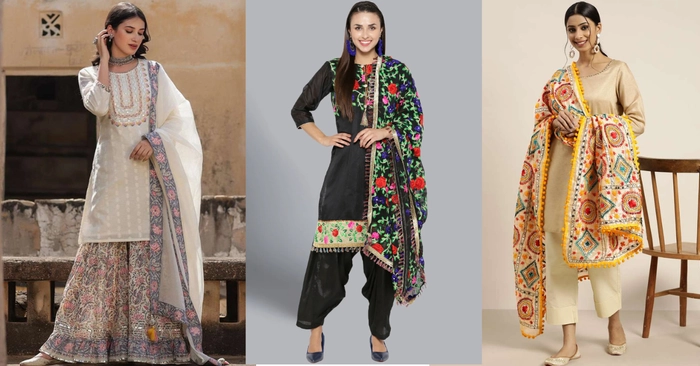Beyond decorative needlework, Phulkari embroidery is an artistic expression that has been treasured for centuries. Phulkari embroidery ethnic wear continues to be the wealth of Punjab’s unmatched craftsmanship. Today, it serves as a vibrant expression of culture, tradition, and identity bearing incomparable artistry.
Phulkari translates to flower work and Phulkari embroidery is truly representative of the name; it includes floral motifs and intricate patterns that serve as defining characteristics of this type of embroidery.
The Origins of Phulkari Embroidery
Like many forms, Phulkari has a rich story behind it. Punjabi folklore gave references to Phulkari embroidery alongside historical texts. While scholars trace its roots to Central Asia and Iran, it is widely believed to have evolved in Punjab’s agrarian society.
Phulkari started as an form created by women in rural communities. Each piece using this intricate craftsmanship was intended to weave powerful stories by incorporating emotions, beliefs, and aspirations. Most commonly, the pieces were depicting scenes from daily life or symbolic motifs that were representative of the culture.
Phulkari embroidery is attributed to the area of Punjab, which prides itself on unique forms. It was believed to be done on handwoven khaddar fabric and silk threads and was considered embroidery on clothing. It was stunted in development at the time due to the industrial revolution but with the advancements in technology, it refined into a more sophisticated form. Furthermore, phulkari is often regarded as one of the most stunning forms of silkwork adornment due to the intricate geometric patterns created with darning stitches. The colors whose hues were used are predominantly red, orange, pink and yellow, which serve to symbolize joy.
Phulkari Ethnic Wear and Its Evolving Cultural Significance
The stitches free in Khaddar Punjabi silk clothes, Phulkari, are not just aimed for that special occasion. Rather, every momentous occasion, such as the Harvest Festival or Lohri, is celebrated with Phulkari ethnic wear, making it a cultural bari eid representation for all Punjabis. The joyous nature of the clothing serves as a valuable yet practical reminder of the family heritage. Each and every stitch tells a story, capturing life in rural areas while also encapsulating flora and fauna.
Modern Revival of Phulkari Embroidery
Traditional Phulkari has managed to incorporate itself into modern-day fashion seamlessly. Today’s craftsmen are using ethnic wear appealing to modern sensibilities as their canvas, using traditional techniques to innovate styles of skirt blouses and blouses, shawls, and suits. Suits, shawls, sarees, and kurtis are just some types of ethnic wear available embroidered with phulkari today, and they now come in numerous designs for diverse audiences all over the world.
The sustainable fashion trend is one of the other reasons for this particular revival. Phulkari helps support the slow fashion movement by handcrafting clothes Phulkari embroidered textiles celebrate the artistry of artisans and minimize environmental harm. From the threads to the patterns, the inspiration that the Punjab artisans, the Phulkari embroidery masters, offer the world is indeed vibrant.
Why Choose Phulkari Ethnic Wear?
Phulkari ethnic wear captures culture distinctively while offering beautiful attire, which proves why Phulkari embroidery is so special. Here is what fuels its use during special occasions:
- Timeless Appeal: From the intricate patterns to the bright colors used in Phulkari garments, each aspect is a piece of art that is truly timeless.
- Versatility: From contemporary Phulkari embroidered kurtis to traditional dupattas, each piece can be worn for multiple occasions and styled in various ways.
- Cultural Connection: At the same time it enables an individual to celebrate the Punjabi heritage, wearing Phulkari ethnic wear enables one to embrace sustainable fashion.
The Role of Artisans in Preserving Tradition
What makes Phulkari beautiful is the artwork itself: the handwork done by women in Punjab over the ages. Every single one of these skilled artisans spends innumerable painstaking hours working on detailed designs that manifest both her ethnic and sophisticated artistic sentiments. Supporting Phulkari embroidery is important in sustaining this heritage and also helps economically empower artisans.
Phulkari On Offer In The Downtown Edmonton
However, for those that reside in the rural parts of the Edmonton region, such as in downtown Edmonton around Rogers Place and the ICE District, integrating cultural gems like Phulkari into their wardrobe enhances their fashion palette. With summers in Edmonton bursting with festivals and concerts and community engagements, there is an alternative approach that can also be used, which is to wear Phulkari ethnic wear and show appreciation for other cultures while still being unique in the city.
Conclusion: Heritage can also be celebrated with FabPotli
The ethnic wear of Phulkari embroidery has much more to offer than just a cloth; it is a blend of heritage, old and new art forms, sophisticated artistry, and patriotism. The vibrant threads not only narrate the story of their origins in Punjab, but also serve as a source of inspiration for fashion trends worldwide.
We at FabPotli understand the need for modern women’s fashion, which is both stylish and comfortable. Each woman is unique, and so are her preferences. At FabPotli, we help you explore your individuality by enabling you to express yourself through fashion. Our collection helps you appreciate and wear traditional Phulkari ethnic wear while blending it with modern and contemporary fashion. Visit us today and experience how FabPotli marries tradition with modern and contemporary styles for every woman and every occasion.

